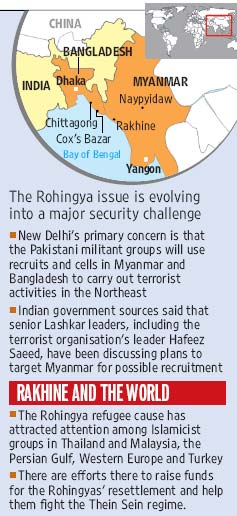LeT seeks foothold in Myanmar

Shishir Gupta, Hindustan Times
New Delhi, January 30, 2013
The Indian government is sharing information with its eastern neighbours — Myanmar and Bangladesh — about the increasing role of Pakistan-based terrorists groups in events like the 2012 sectarian violence between Rohingya Muslims and Buddhists in the coastal Rakhine state of
Myanmar.
Among the most prominent groups is the Lashkar-e-Taiba.
Senior Indian government sources say that intelligence inputs available to them indicated that Rohingya Muslim extremist activity was being funded mainly from groups in Saudi Arabia.
The militant cadres were being trained by Pakistan-based terror groups and the weapons being sourced from Thailand.
“Economic and social hardships faced by Rohingya refugees apart, the involvement of the minority group in arms smuggling. narcotics, safe sanctuaries for terror elements including setting up of training camps is going to be a major counter-terrorism challenge in the regional context,” said a senior Indian official.
New Delhi’s primary concern is that the Pakistani militant groups will use recruits and cells in Myanmar and Bangladesh to carry out terrorist activities in the Northeast and try to encourage communal violence in places like Assam.
India and Bangladesh, both of which have significant Rohingya Muslim refugee communities, have exchanged notes on the stepped-up operations by the Pakistani Inter-Services Intelligence and the Lashkar.
They also believe there has been activity by the Jaish-e-Mohammed (JeM) in Bangladesh’s Chittagong Hill Tracts — especially the area from Cox’s Bazaar to the Teknaf sub-division along the border with Myanmar.
After Rakhine’s sectarian riots, the Lashkar and its parent organisation, the Jammaat-ud-Dawwa (JuD), formed a new forum — Difa-e-Musalman Arakan-Burma Conference (Defence of Muslims in Myanmar) — in order to mobilise supporters for a campaign against the ruling military junta of Myanmar.
The Lashkar and Jammaat deputed a two-member team comprising Jammaat spokesperson Nadeem Awari and a member of the Jammaat’s publication wing, Shahid Mehmood Rehmatullah, on August 10, 2012, with the task of forging links with senior representatives of Islamic institutions in Bangladesh and Myanmar.
Indian government sources said that senior Lashkar leaders, including the terrorist organisation’s leader Hafeez Saeed, have been discussing plans to target Myanmar for possible recruitment and militant activism.
The Lashkar blames the reformist Thien Sein government of Myanmar for the plight of Rakhine Muslims.
“Pakistan-based Lashkar commanders are planning to visit the restive Rakhine state in Myanmar with other outfits like Harkat ul Jihadi al Islami (HUJI), JeM and Jammaat ul Mujahideen Bangladesh (JMB) to build reltations with the Rohingya Solidarity Organisation in a bid to expand activity and establish new bases on India’s eastern fringes,” said a senior official.
India’s internal security agencies have informed the Manmohan Singh government about the formation of a new front called the Jammaat ul Arakan (JuA) with elements from JMB and other extremist Rohingya entities.
“Reports indicate that the JMB could also be involved in running militant training camps in remote areas of Bandarban district of Bangladesh. They may have plans to undertake action in Myanmar,” said an official.
The expanding ISI footprint in the Rohingya belt was revealed following the arrest of one Noor-ul-Amin from the Idgah madarassa in Cox’s Bazaar, Chittagong, on September 11, 2012.
A cleric recruited from Dar-ul-Uloom Islamiya madarassa in Karachi, Noor-ul-Amin had served as a militant talent spotter and a recruiter of Rohingya cadres in the past.
During his interrogation, Amin confirmed his association with the ISI and also the Karachi-based Maulana Abdus Qudus Burmi, so-called chief of HUJI (Arakan).
He also confirmed that the Pakistan military intelligence agency was involved in gun-running in the Rohingya refugee belt.
Subsequently, Noor-ul-Amin’s close associate Ali Ahmed aka Abu Jibral was also picked up by Bangladeshi security agencies on October 8, 2012.
He was involved in the money transactions between the ISI and the Karachi Islamiya madarassa the previous month.
During interrogation, Jibral described his days in Afghanistan as a jihadi soldier and his association with the Taliban during his stay in Miranshah, North Waziristan, from 1985 to 1994.
An active member of HUJI, Jibral was caught with Pakistani documents and a Bangladeshi passport.
While alerting Dhaka and Naypyidaw to the emerging Rohingya terror threat, India is worried about the growing ISI interest in Muslim refugees in the restive Rakhine state through terror groups like Lashkar, Jaish, HUJI and the Tehrik-e-Azadi Arakan (TAA) as trained extremists could be used to create mayhem in India’s Northeastern states.
The growing radicalisation of the Rohingya’s Muslims is combining with evidence of Pakistan-based explosive experts teaching more militant refugees how to manufacture improvised explosive devices to fight Myanmar security forces.
http://www.hindustantimes.com/India-news/NewDelhi/LeT-seeks-foothold-in-Myanmar/Article1-1004198.aspx


